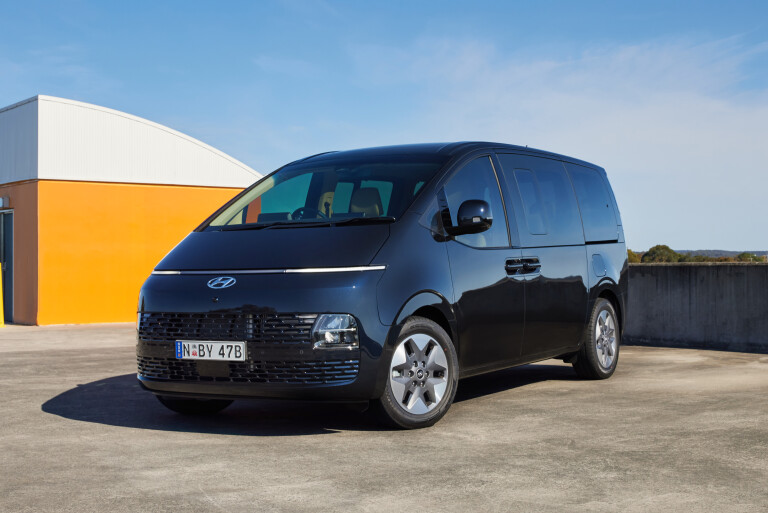Latest Review
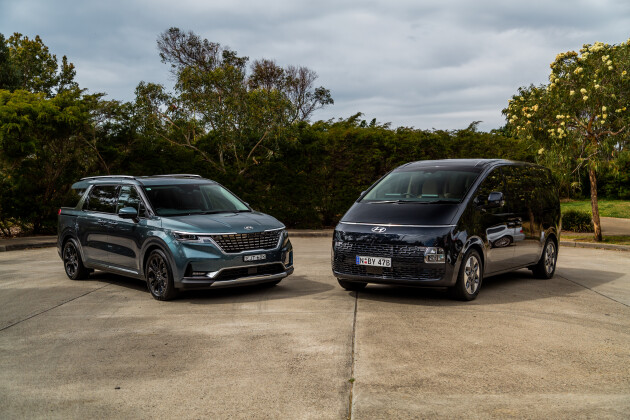
People-movers compared: Hyundai Staria vs Kia Carnival review
Hyundai has re-entered the space race with its boldly styled Staria MPV. Can it steal the MVP (Most Valuable People-Mover) award from the segment’s current benchmark?
The Kia Carnival enjoys the kind of segment dominance that might persuade every other car manufacturer to give it a miss. Introduced as a fourth-generation model as recently as last year, it currently accounts for three in five people-mover sales.
Even Toyota has abandoned the Carnival’s territory, ditching the purpose-built, once-loved Tarago for the much costlier Granvia that’s based on the HiAce van.
And affiliate company Hyundai had seemingly given up, allowing its iMax people-mover to toil for 14 long years – its dearth of safety and tech features particularly glaring in recent times.
But Hyundai is back in play with a new MPV contender that, like the Carnival, aims to deliver eight-seater practicality in a vehicle design that’s more interesting than your typical multi-human transporter.
The futuristically styled Staria looks like Robocop’s helmet from the front; remove the wheels and you could almost envisage it whisking a Starfleet crew off to a rendezvous with the USS Enterprise.
A sleekly curved silhouette and deep panoramic windows create a visually arresting design that otherwise follows the iMax with van-like proportions. And there is a commercial-van spin-off – with the Staria-Load that replaces the iLoad.
And it is the van that’s spun off the people-mover this time. The Staria has switched to the Carnival’s front-wheel-drive, passenger car platform that’s also shared with the Sorento and Santa Fe SUVs.
It takes a big car to make the Carnival look relatively small, and the Staria does achieve that feat.
At 5253mm nose to tail, it’s about 14cm longer; at 1990mm ground to roof, it’s nearly 22cm taller. (The Staria is still slightly shorter than a long-wheelbase VW Multivan, though.)
As with the third-generation model, the Carnival fuses various body styles – wagon, SUV and MPV. Many would say successfully.
The Staria looks like Robocop’s helmet; remove the wheels and you could envisage it whisking a Starfleet crew off.
Pricing and features
We have both vehicles here in range-topping guises that are becoming increasingly popular with buyers. That’s Highlander for the Staria and Platinum for the Carnival. And each is powered by a four-cylinder turbo-diesel rather than a cheaper V6 petrol.
The Hyundai Staria Highlander diesel costs $66,500, or about $69,500 with on-road charges added. That gives it a slight saving on the Kia Carnival Platinum diesel, which carries a $66,980 RRP but has slightly more expensive on-roads to cost $70,790 drive-away.
As would be expected at this price point, each flagship model is comprehensively equipped. There are some spec differences, a key one of which is that the Staria diesel comes with a part-time all-wheel-drive system where the Carnival’s diesel powers the front wheels only.
Most manufacturers charge several thousand dollars as a premium for AWD, so there’s already a value advantage for the Hyundai.
All Staria models wear the same 18-inch alloy wheels, but the Carnival Platinum is fitted with the biggest wheels in the range: 19 inches.
Leather-appointed seats are found in both vehicles.
Safety
The Staria has yet to crash-tested by ANCAP, though eyebrows would be raised if it didn’t match the maximum five stars achieved by the related Carnival.
Both vehicles include curtain airbags that fully extend to the third row – unlike the car makers’ seven-seater SUVs, the Kia Sorento and Hyundai Santa Fe, which cover the third-row glass only.
The airbag approach at the front of the cabin differs. The Kia is equipped with driver’s knee protection; the Hyundai features a front centre airbag designed to inflate in the event of a nasty side impact to prevent the heads of the driver and front passenger coming together.
Safe Exit Warning and Assist are also standard on both vehicles, which not only flash if the rear doors are about to opened with traffic approaching but auto-lock them, too.
Driver aids are also prevalent. The models share features such as adaptive cruise control, various lane-assist systems, lead-vehicle depart notification, auto high beam, blind-spot and rear cross-traffic monitoring, fatigue alert and speed limit notification. The Staria adds a blind-spot monitor in its driver display.
Each comes with LED headlights, DRLs and foglights. For parking assistance, there are front/rear sensors as well as surround-view cameras. The Staria’s 360-degree monitor adds a 3D effect.
Infotainment
Touchscreens are a good size in both vehicles, though larger in the Carnival: 12.3 inches versus 10.25 inches. (Base models in both cases come with smaller, 8.0-inch touchscreens.)
They share the same software and (simple) functionality, however, the presentation differing slightly in terms of graphics.
Apple CarPlay and Android Auto are included (wirelessly connected only in base models, though), as are digital radio and the ability to pair two smartphones simultaneously.
Wireless smartphone charging is standard in all Staria models but limited to the Platinum in the Carnival line-up.
Strangely, the Highlander Staria misses out on a branded audio system, sharing a basic six-speaker setup with other grades. The Platinum Carnival brings a range-exclusive 12-speaker Bose system including surround sound.
The Staria has yet to crash-tested by ANCAP, though eyebrows would be raised if it didn’t match the five stars achieved by the related Carnival.
Boot space
One of the obvious reasons to choose one of these people-movers over a multi-seater SUV is luggage capacity when all seats are in use. Both the Carnival and Staria excel here, albeit in different ways.
Kia opts for a deep boot where Hyundai has a flat cargo floor but plays to the Staria’s dimensional advantage.
Quoted figures point to a sizeable advantage for the Staria – 831 versus 627 litres – yet even the Carnival’s boot makes it both a viable airport shuttle and practical holiday transport for a large family.
Cargo space can be expanded, again in quite different ways. The Carnival’s rear seats – divided into a 50-50 arrangement – push-fold down cleverly into the floor. It creates a whopping volume of 2785 litres behind the second row.
The Staria can’t even match half of that, managing 1303 litres through limitations to its third-row versatility. The seats can’t be removed, as in a Multivan; instead, levers can be used to flip up the third-row cushion so the one-piece seatback can be pushed forward to lock up against the back of the second row.
Auto tailgates with hands-free open and close (when the keyfob is in your pocket) are standard in both instances.
(PS: You won’t find spare wheels under the boot floors – they’re under the vehicles: directly under the boot area with the Carnival; between the axles on the driver’s side with the Staria.)
Third row
Higher-spec versions of the Carnival and Staria feature hands-free electric sliding doors and tilt-slide second-row seats, which help create easy access to both sets of rear seats.
Other commonalities for the Platinum and Highlander are ceiling vents, LED reading lights, storage trays and USB ports, and window blinds.
You’ll also find more space in the third row than your average seven-seater SUV.
There’s significantly more headroom in the Staria; an inherent advantage delivered by its much taller roofline.
And while three adults can fit across in both vehicles, the middle adult will be more comfortable in the Hyundai thanks to extra shoulder room. The Staria’s seatback also incorporates a regular seatbelt where the seatbelt must be pulled down from the ceiling in the Carnival and will be felt on the neck more by some passengers.
Yet the Kia’s third row is ultimately the more versatile; certainly for parents. Where the Staria's third row fails to offer any kind of child-seat anchorage, the Carnival features both ISOFIX and top-tether points in the outboard seats.
Second row
Adults and kids alike should cherish the middle rows on offer here. Legroom is in abundance even when the sliding seats are brought forward to allow more knee space for third-rowers.
The Carnival’s trio of seats move individually where the Staria’s slide in a 60-40 split.
There’s recline adjustment all round, though only the Kia provides fold-down outer armrests for the outboard seats.
Another useful trick in the Kia is a super-flexible centre middle seat: it can be flipped 180 degrees to face third-row occupants, it can be slid forward to bring a child closer to the parents up front, or the seatback can be folded down to create a table with cupholders. It can also be removed completely to create a walk-through to the third row.
In both vehicles, ISOFIX points feature in the outer seats and top-tether anchors across all three seats. Importantly, ISOFIX-fitted child seats allow the outer seats to move forward without a seatbelt hindering third-row access.
All but base models add climate control for the second row. The Carnival Platinum has heated outboard seats as an exclusive both in the range and in this comparison.
Dual sunroofs are standard in these top-spec models. The rear glass sunroof opens only in the Carnival.
Both models come with second-row window blinds.
The Staria’s side windows aren’t as deep and panoramic as the exterior design promises, with the view partially interrupted by an integrated flush sliding window (or a pop-latch window in the base Staria). The Carnival’s windows rise and lower in a conventional fashion.
Second-row passengers in the Carnival and Staria are treated to plentiful storage, with the Hyundai offering that bit more with its storage drawer that pulls out of the rear centre console, dual rather than single door bottle-holders and seatback pouches that incorporate neat little individual net pockets for smartphones.
The Staria’s side windows aren’t as panoramic as the design promises, with the view partially interrupted by an integrated sliding window
Front cabin
The Carnival’s driving position is slightly more upright in relation to the Sorento but still has more in common with an SUV than either a passenger car or van.
There’s a wide range of electric adjustment for both front seats and their general comfort is complemented by heating and ventilation functions (and a heated steering wheel). Cabin ergonomics are excellent, too, with key controls clearly labelled and easy to reach.
A huge, wide centre console box doubles as a centre armrest.
Storage is otherwise unremarkable, particularly the door pockets that are narrower and shallower than ideal. The Platinum is also the only Carnival to feature a wireless charging smartphone tray.
You climb into the Staria’s front seats, marking an immediate difference. The seats provide a more elevated view, though they’re not as comfortable as the Carnival’s – even more upright, lacking both lateral and under-thigh support, and no armrests of any kind.
There’s no escaping the feeling that you’re driving a van-style vehicle, further emphasised by the walk-through gap to the front passenger seat and a greater prevalence of hard plastics compared with the Carnival.
This seat also surprisingly misses out on electric adjustment, though both seats match the Carnival Platinum for heating and ventilation.
The Staria excels for front-cabin storage, however. There’s a large centre storage box with a sliding lid and internal cupholders, with additional cupholders for front occupants (pop-out for the front passenger; integrated into the dash for the driver).
A wireless charging slot is standard on all models, while the Highlander gains extra lidded dash compartments over other grades.
The Staria’s front doors are particularly clever, with four layers of storage ranging from a shallow tray on the upper door card to generously sized lower compartments.
Hyundai’s people-mover also provides some extra technology.
The Highlander version of the Staria is equipped with a 10.25-inch digital driver display that is meant to be coming to the Carnival Platinum sometime soon.
And the Hyundai will delight parents with its Passenger View Monitor, which when selected via the touchscreen uses a ceiling-mounted camera to provide a feed of the second and third rows. Watch out, naughty kids!
The Carnival’s driving position is slightly more upright in relation to the Sorento but still has more in common with an SUV than either a passenger car or van.
Hyundai Staria vs Kia Carnival: How do they drive?
Reflecting their front seat setups, the Kia Carnival and Hyundai Staria feel different behind the wheel despite sharing key components and a platform – more SUV-like and more van-like, respectively.
However, the steering is slower in both cases compared with the manufacturers’ seven-seater SUVs, so even the Carnival isn’t as effortless to manoeuvre around town or drive on a windy country road compared to the Sorento.
The Kia’s steering has a vague patch around the straight-ahead position that makes it feel less precise than the Hyundai’s on straighter roads such as freeways.
Turning circles are better than expected for two long vehicles. Find a parking space of sufficient size and sensors galore, 360-degree cameras and light steering make the task of slotting into it easier. The sliding rear doors are also helpful in car parks, too, of course.
Vision out is good in both, too, with the Staria the pick courtesy of its higher seating, vast windscreen, and large side mirrors. It also gains extra blind-spot assistance via a video feed in the digital instrument cluster.
Both people-movers ride with a good level of comfort. The Staria’s suspension tends to be upset more by rougher roads with just a driver, settling better over bumps when a family of four was aboard. The Carnival is pleasantly compliant regardless of occupant numbers and is generally smoother than the stablemate Sorento Platinum that also wears big, 19-inch wheels.
All-round refinement is a clear win to the Carnival. It produces less wind noise at higher speeds and less road noise on coarser surfaces.
And while these two people-mover protagonists share a related diesel engine (and eight-speed auto), it’s quieter in the Kia. Traditional diesel clatter is more obvious in the Staria at idle and low revs, while the 2.2L is noisier under load.
The Kia also offers stronger acceleration, and its auto is better at coping with steep hills where the Staria can fumble a downshift.
Although the Carnival produces slightly more torque – 440Nm versus 430Nm – the key difference is weight. Where the Kia registers 2134kg on the scales, the Hyundai is nearly 200kg heavier, at 2325kg.
That contributes to a gap in official fuel consumption, too, with the Carnival quoted at 6.5 litres per 100km against the Staria’s 8.2L/100km.
There will be buyers happy to trade off performance and consumption deficiencies for the benefits of the Staria diesel’s all-wheel-drive system. And in the dry at least, the Staria won’t spin up its front wheels like the Carnival if trying to accelerate quickly out of a junction.
The Staria has a higher braked towing capacity, rated at 2500kg compared with 2000kg for the Carnival. It’s not a straightforward advantage, however, as the Hyundai’s towball rating is a relatively low 100kg where the Kia’s is 200kg.
Gross vehicle weight is another factor to consider for both towing and carrying people. The figure is 2876kg for the Carnival Platinum diesel and 3040kg for the Staria Highlander diesel.
Deduct the kerb weights from these numbers and you’re left with 715kg (Staria) and 742kg (Carnival) for people and luggage. Or an average weight of 92.8kg per passenger for the Kia compared with 89.4kg for the Hyundai.
Ownership
Kia’s now-famous seven-year warranty gives Carnival owners an extra couple of years of peace of mind over those who purchase a Staria. It also helps make the Carnival an attractive proposition for second-hand buyers as the warranty passes on.
Servicing intervals for both vehicles are the industry standard 12 months or 15,000km. Maintenance visits for the Carnival currently cost $1382 for three years, $2573 over five years, and $3767 if kept for the full warranty period of seven years.
The Staria is cheaper to service, with pricing capped at $360 for each of the first five visits. That’s a total of $1080 over three years or $1800 over five years.
Roadside assistance is renewed with each factory-endorsed service.
VERDICT: Kia Carnival or Hyundai Staria?
The Staria brings Hyundai bang up to date in the people-mover segment, bringing technology and a driving experience significantly better than the iMax.
There’s also fantastic space for adults in any of the rear seats, while all-wheel drive on the diesel gives buyers a rare option in the category alongside a 4Motion VW Multivan.
The anti-bland futuristic styling also ensures there’s nothing boring about the way it looks, even if it may polarise opinions.
In many ways, the latest Carnival is simply an updated version of the third-generation model introduced in 2015. Yet Kia was wise not to tinker excessively with a hugely successful formula because this is a people-mover that absolutely nails its brief with an outstanding combination of interior space and seating versatility for big families (or big fleets).
And that the Carnival’s design more closely resembles an SUV than any other competitor certainly doesn’t hurt its cause.
All-wheel drive on the diesel Staria gives buyers a rare option in the category alongside a 4Motion VW Multivan.
RATINGS
Staria vs Carnival: Specifications
News
-
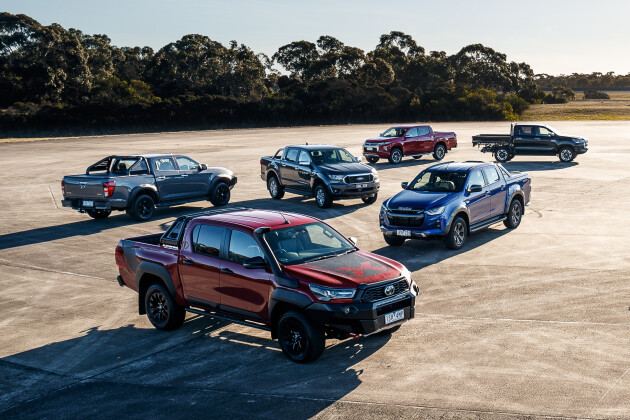 News
NewsEOFY 2022: Best deals on utes and vans
Looking for a good deal this EOFY season? Look no further – we've found you all the latest commercial vehicle offers
-
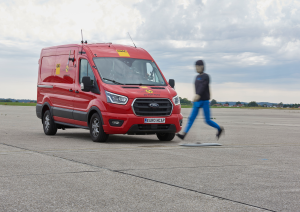 News
NewsANCAP reveals van safety comparison for 2022
More poor results for Mitsubishi and Renault's commercial offerings
-
 News
News2021 Hyundai Staria and Staria-Load receive five-star ANCAP rating
Both passenger and commercial variants score top marks
-
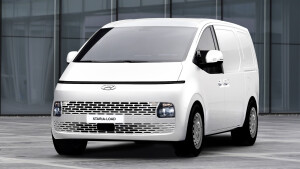 News
NewsHyundai reveals pricing and features of 2022 Staria-Load
New Hyundai van aims to win back buyers in the commercial segment
-
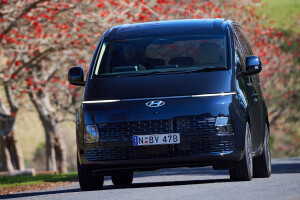
Hyundai says Staria is aimed at convincing SUV buyers into people-movers
-

Hyundai confirms semi-conductor supply hasn't impacted Staria features
-
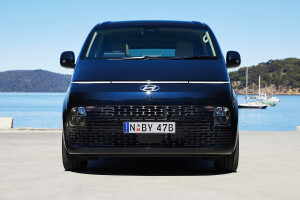
Hyundai Staria on sale in Australia
-
.jpg)
Hyundai Staria due in local showrooms in August

